How BRICS and India’s UPI Could Forge a New Path in Global Finance
The BRICS coalition—expanded to include Brazil, Russia, India, China, South Africa, and now Iran, Egypt, Ethiopia, and the United Arab Emirates (UAE)—is strengthening its influence in global trade and finance. With these new members, BRICS is signaling a commitment to economic diversification and reducing reliance on traditional dollar-dominated systems. This year’s BRICS Summit in Kazan, Russia, highlighted a pivotal initiative: creating alternatives to dollar-based transactions. India’s Unified Payments Interface (UPI) emerged as a promising tool in this effort, offering a model for BRICS members to conduct cross-border transactions in local currencies and enhance financial independence. Here’s how UPI could reshape the BRICS financial landscape and support this growing coalition.
The Dollar Dilemma for BRICS Nations
With around 60% of international transactions conducted in US dollars, the dollar grants the US significant control over global financial systems. This reliance can adversely impact emerging economies when the Federal Reserve adjusts monetary policies. During the recent surge in the US M1 money supply, these effects reverberated globally, particularly impacting countries heavily trading in dollars. BRICS members, projected to account for nearly 50% of global GDP by 2030, have prioritized a balanced, de-dollarized financial ecosystem to stabilize and strengthen their economies.
UPI’s Success: A Proven Model
Since its launch in 2016 by the National Payments Corporation of India, UPI has transformed digital payments in India. In FY24 alone, the platform processed 13,115 crore transactions with a cumulative value of ₹199.29 lakh crore, marking a 56.6% increase in transaction volume and a 43.4% increase in transaction value from FY23. In FY23, UPI had processed 8,376 crore transactions worth ₹139 lakh crore, showcasing the platform's impressive year-on-year growth. This success is attributed to UPI’s zero-cost transaction model and QR-code-based convenience, making it India’s preferred digital payment method.
International interest in UPI has also been growing. With over 30 countries exploring adoption—including BRICS member UAE, where UPI is already integrated—UPI’s flexibility and low-cost structure highlight its potential as a cross-border payment solution for BRICS.
Real-Time Data on UPI’s Impact in FY24:
- 13,115 crore transactions processed, up 56.6% from FY23
- ₹199.29 lakh crore in cumulative transaction value, up 43.4% from FY23
- Over 30 countries interested in UPI adoption, with live implementations in the UAE, Singapore, and Bhutan.UPI Success Metrics (FY24)
Why UPI is Ideal for BRICS Expansion
The Kazan Summit demonstrated BRICS’s commitment to finding alternatives to dollar-based systems. UPI’s efficient, real-time, and highly scalable infrastructure is uniquely positioned to meet these needs. UPI’s successful integration in the UAE and expansion into other countries signal its readiness for broader BRICS-wide adoption. If implemented across BRICS, UPI could securely manage high transaction volumes, making cross-border payments easier and fostering stronger economic collaboration within the bloc.
The Benefits of UPI for BRICS Economies
- Lower Transaction Costs: UPI’s zero-cost model is highly attractive, particularly for small businesses and individuals across BRICS.
- Financial Inclusion: UPI’s mobile-based, user-friendly interface could expand access to financial services, fostering broader economic participation across BRICS.
- Currency Independence: By supporting local currency transactions, UPI would allow BRICS members to bypass dollar-based transactions, reducing exposure to inflation and other external policy risks.
- Enhanced Trade and Investment: A shared digital infrastructure would streamline intra-BRICS investments and transactions, strengthening economic ties without reliance on foreign (dollar-based) funding.
The Road Ahead: UPI and BRICS’s Financial Independence
The Kazan Summit underscored BRICS’s commitment to reshaping its economic landscape, and with the recent additions of Iran, Egypt, Ethiopia, and UAE, the bloc is better positioned than ever. UPI’s real-world success offers a scalable model for a de-dollarized economy, supporting financial independence across the BRICS nations.
A Blueprint for a Self-Sustained Economic Future
India’s UPI system provides BRICS with a powerful tool for building a more stable, autonomous financial framework. The additions of Iran, Egypt, Ethiopia, and UAE expand the coalition’s reach, positioning BRICS to establish a de-dollarized economy. The Kazan Summit underscored BRICS’s determination to redefine its financial independence, with UPI potentially serving as the linchpin of this vision. A successful UPI expansion could empower BRICS as a self-sustaining economic coalition, steering its own financial future.

